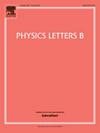Electroweak hierarchy from conformal and custodial symmetry
IF 4.3
2区 物理与天体物理
Q1 ASTRONOMY & ASTROPHYSICS
引用次数: 0
Abstract
We present “Custodial Naturalness” as a new mechanism to explain the separation between the electroweak (EW) scale and the scale of potential ultraviolet completions of the Standard Model (SM). We assume classical scale invariance as well as an extension of the SM scalar sector custodial symmetry to . This requires a single new complex scalar field charged under a new gauge symmetry which partially overlaps with . Classical scale invariance and the high-scale scalar sector custodial symmetry are radiatively broken by quantum effects that generate a new intermediate scale by dimensional transmutation. The little hierarchy problem is solved because the Higgs boson arises as an elementary (i.e. non-composite) pseudo-Nambu-Goldstone boson (pNGB) of the spontaneously broken custodial symmetry. The minimal setting has the same number of parameters as the SM and predicts new physics in the form of a heavy with fixed couplings to the SM and a mass of , as well as a light but close-to invisible dilaton with a mass .
从共形对称和监护对称看电弱层次
我们提出了“监护自然性”作为解释标准模型(SM)的电弱尺度和潜在紫外补全尺度之间的分离的新机制。我们假设经典尺度不变性以及SM标量扇区保管对称的扩展到SO(6)。这需要一个新的复标量场,在新的U(1)X规范对称下带电,它与B−L部分重叠。经典尺度不变性和高尺度标量扇区SO(6)看守对称被量子效应辐射打破,量子效应通过维度嬗变产生新的中间尺度。由于希格斯玻色子是自发破缺的SO(6)保护对称的基本(即非复合)伪nambu - goldstone玻色子(pNGB),所以这个小层次问题得到了解决。最小设置具有与SM相同数量的参数,并预测了新的物理形式,即与SM固定耦合的重Z ‘,质量为mZ ’≈4−100TeV,以及质量为mhΦ≈75GeV的轻但接近不可见的膨胀子。
本文章由计算机程序翻译,如有差异,请以英文原文为准。
求助全文
约1分钟内获得全文
求助全文
来源期刊

Physics Letters B
物理-物理:综合
CiteScore
9.10
自引率
6.80%
发文量
647
审稿时长
3 months
期刊介绍:
Physics Letters B ensures the rapid publication of important new results in particle physics, nuclear physics and cosmology. Specialized editors are responsible for contributions in experimental nuclear physics, theoretical nuclear physics, experimental high-energy physics, theoretical high-energy physics, and astrophysics.
 求助内容:
求助内容: 应助结果提醒方式:
应助结果提醒方式:


